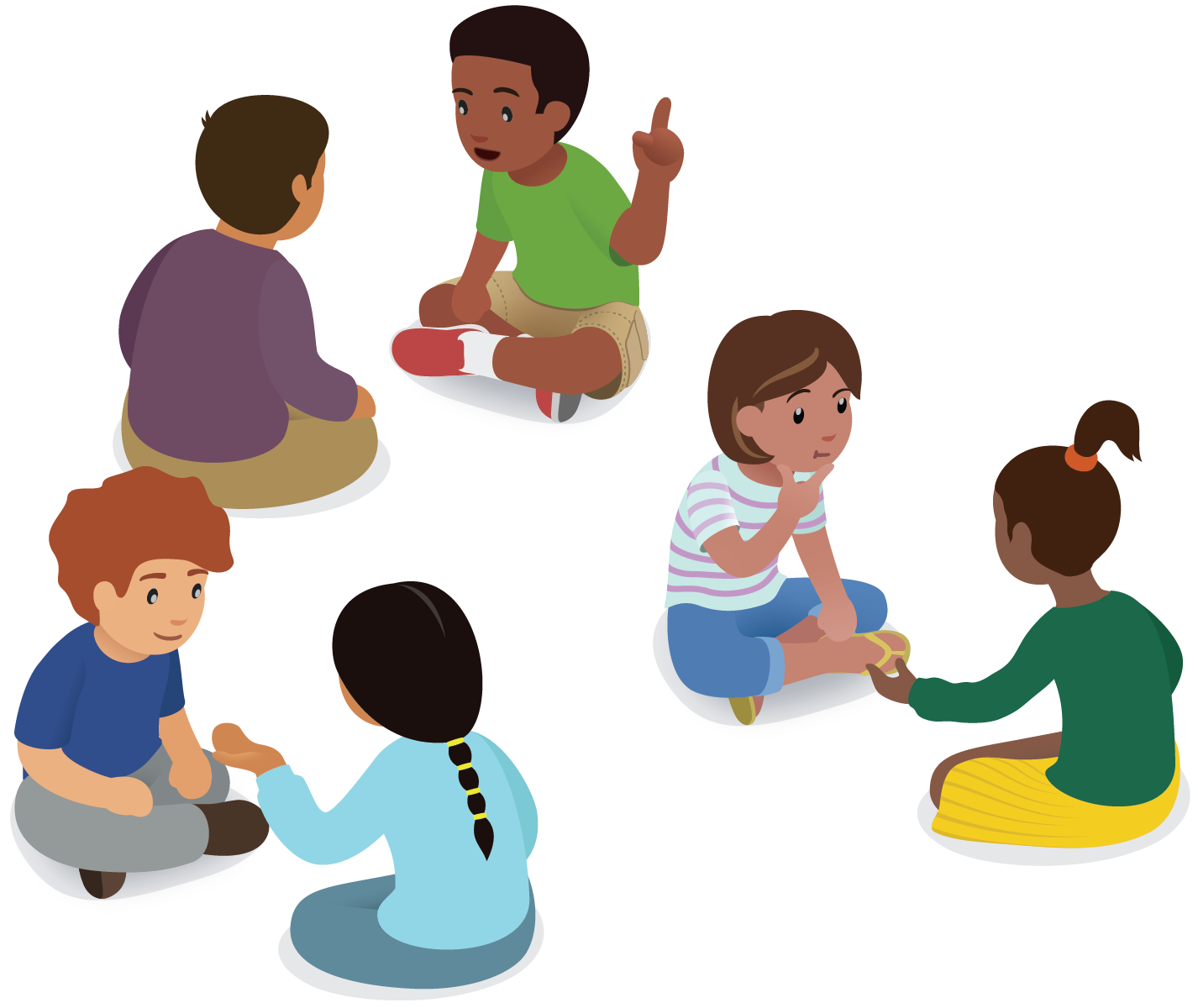Lesson 1
Count and Add
Warm-up: What Do You Know About Math? (10 minutes)
Narrative
The purpose of this activity is to elicit ideas students have about doing math. Students learn the What Do You Know About _____ routine, which will be used throughout the year. This routine provides an opportunity for all students to contribute to the conversation and for the teacher to listen to what knowledge students already have.
For all the routines, consider establishing a small, discreet hand signal that students can display to indicate they have an answer they can support with reasoning. This signal could be a thumbs-up, a certain number of fingers that tells the number of responses they have, or another subtle signal. This is a quick way to see if students have had enough time to think about the problem. It also keeps students from being distracted or rushed by hands being raised around the class.
Launch
- Groups of 2
- Display the question.
- “What do you know about math?”
- 1 minute: quiet think time
Activity
- Record responses.
Student Facing
What do you know about math?

Student Response
For access, consult one of our IM Certified Partners.
Activity Synthesis
- “Today, you will get to do math in different ways.”
Activity 1: Revisit Counting Collections, Up to 20 (20 minutes)
Narrative
The purpose of this activity is for students to count collections of up to 20 objects and represent their count in a way that makes sense to them. Students may use drawings, numbers, or words to represent their count.
This activity provides an opportunity to gather formative assessment data on students’ counting skills and understanding. Some students may have more sophisticated counting methods such as grouping and counting by twos or tens (MP7). Students are not expected to do this at this point, as students will continue to engage in Counting Collections throughout the year. Collections of objects should be saved for use in later lessons.
10-frames are provided as a blackline master. Students will continue to use these throughout the year. Consider copying them on cardstock or laminating them and keeping them organized to be used repeatedly.
Advances: Listening, Representing
Supports accessibility for: Conceptual Processing, Organization
Required Materials
Materials to Gather
Materials to Copy
- Counting Collections Stages 1 and 2 Recording Sheet
- 10-Frame Standard
Required Preparation
- Create one collection of up to 20 objects such as buttons, counters, connecting cubes, paper clips, square tiles for each group of 2.
Launch
- Groups of 2
- Give each group a collection of objects, two recording sheets, and access to 10-frames.
- Show students a collection of 10–20 objects.
- “We are going to start with some counting. You and your partner will get a collection of objects like this one. Your job is to figure out how many objects are in your collection and show how many.”
- “What are some different ways you and your partner can work together to count the collection?” (One person can count first and then the next can count to see if they get the same amount. We can take turns moving an object and counting a number.)
Activity
- 10 minutes: partner work time
- Consider asking:
- “How many objects are in your collection? Can you prove it to me?”
- “Can you draw a picture to show how you counted?”
- Monitor for students who organize their objects as they count and create a representation with drawings or numbers.
Activity Synthesis
- Invite previously identified students to share.
- “How did you keep track of the objects as you counted?” (We put each object in a pile after we counted it so we knew we already counted that one.)
- Display previously selected representations.
- “How did they show their count?” (They drew twelve circles. They wrote the number 12.)
- “We counted lots of collections of different things today. What are some things you count at home?”
Activity 2: Introduce: Number Race, Add to 10 (20 minutes)
Narrative
The purpose of this activity is for students to learn a new stage in the center, Number Race. Earlier stages of this center were introduced in kindergarten. In this new stage, called Add to 10, students find the total number of dots on two dot cubes and record the number on their gameboard. This activity gives the teacher an opportunity to see the methods that students use. As students work, observe whether they count each dot to find the total, recognize the number of dots on each cube without counting, count on from one cube, or just know the sum of the two quantities. Students may have fluency with sums within 5, as that was the end of year expectation for kindergarten. Many students may be counting all, and some students may be counting on. It is important to let students develop their own ideas about counting on as this concept develops throughout the year. During the synthesis, students connect counting to addition as they consider representing the total number of dots with an addition expression.
Required Materials
Launch
- Groups of 2
- Give each group two game boards and two dot cubes.
- Display the game board.
- “Now we are going to learn a game called Number Race, Add to 10. Let’s play a round together. I am going to roll both dot cubes and find the total number of dots. How many dots are there? How do you know?”
- 30 seconds: quiet think time
- 1 minute: partner discussion
- Share responses.
- Demonstrate writing the total at the bottom of the appropriate column.
Activity
- “Take turns with your partner. During each turn, roll the dot cubes, find the total number of dots, and show your partner how you know. When you agree, record the total above the number on the game board. If the total is more than 10, roll the cubes again.”
- 10 minutes: partner work time
- As students work, consider asking:
- “How many dots are on this cube?”
- “How did you find the total number of dots?”
- “Look at your game board. Talk to your partner about what you notice.”
- 2 minutes: partner discussion
Student Response
For access, consult one of our IM Certified Partners.
Advancing Student Thinking
- “How did you know how many dots are on this cube?”
- Showing a different number of dots, ask “Can you tell how many dots are on this cube without counting?”
Activity Synthesis
- Display two dot cubes, for example five dots and three dots.
- “There are different ways we can find the total number of dots on the two cubes. Some of us counted all of the dots. Some of us added the number of dots on each cube.”
- Point to one cube.
- “How many dots are on this cube?”
- Repeat with the second cube.
- “We can add these two numbers to find the total number of dots. We can write an expression to show that we are adding these two numbers together.”
- Write the expression \(5 + 3\).
- Roll the two cubes.
- “What expression can we write to show that we are putting together the number of dots on each of these cubes?”
Lesson Synthesis
Lesson Synthesis
“Today we counted math tools and played a math game. We are going to make a chart of what you do and what I do in our mathematical community.”
Math Community
Display chart:

“What does it look and sound like to do math together as a mathematical community?” (We talked to each other and to the teacher. We had quiet time to think. You asked us questions. We shared our ideas. We thought about the math ideas and words we knew. You were writing down our answers. You were waiting quietly until we gave the answers.)
Cool-down: Unit 1, Section A Checkpoint (0 minutes)
Cool-Down
For access, consult one of our IM Certified Partners.